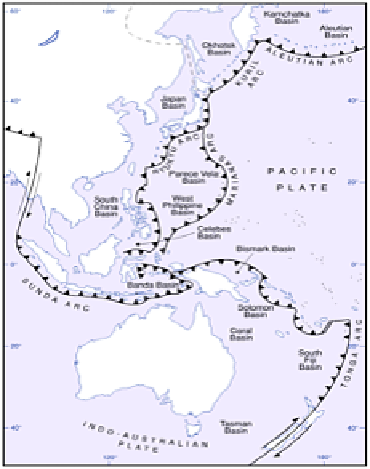Environmental Engineering Reference
In-Depth Information
The back arc, which may be 200-600 km wide, develops by crustal extension of the
non-descending plate, in contrast to general
crustal shortening
or compression in the
subduction zone. This occurs either when continental plate actively overrides the
descending plate and is stretched by trench suction force, or by rifting as the volcanic arc
is elevated or when magma intruded into the continental plate creates a thermal dome or
diapir
(Figure 10.7). Occasionally the back-arc basin contains a remnant arc, abandoned
as the back arc spreads or where subduction migrates
away
from an arc. Subsidence on
extension creates a basin which may flood, and most volcanic arcs impound
marginal
seas
on oceanic plate between them and adjacent continents. North-west Pacific arcs
enclose six such marginal seas in a complex tectonic zone. East of the Philippines there
are two arcs, which meet farther north, as
two
plates subduct beneath Japan
simultaneously, one stacked above the other (Figure 10.9).
MARGINAL ARCS AND CONTINENTAL COLLISION
So far we have reviewed subduction in the oceanic plate context. In the supercontinental
cycle the eventual fate of volcanic arc complexes is to migrate and accrete on to
continental plate. Oceanic subduction 'goes onshore' beneath continental lithosphere in
arc-continent convergence. This is seen at various stages of completion around the
Pacific Ocean and explains its tectonic asymmetry. Intra-oceanic arcs of the western
ocean lie well offshore from Asia, contrasting with continental-margin orogens to the
east. There the Pacific mid-ocean ridge and its
Figure 10.9
Volcanic arcs, back-arc basins and marginal
seas of the western Pacific and Indonesia; key as for
Figure
10.4.

